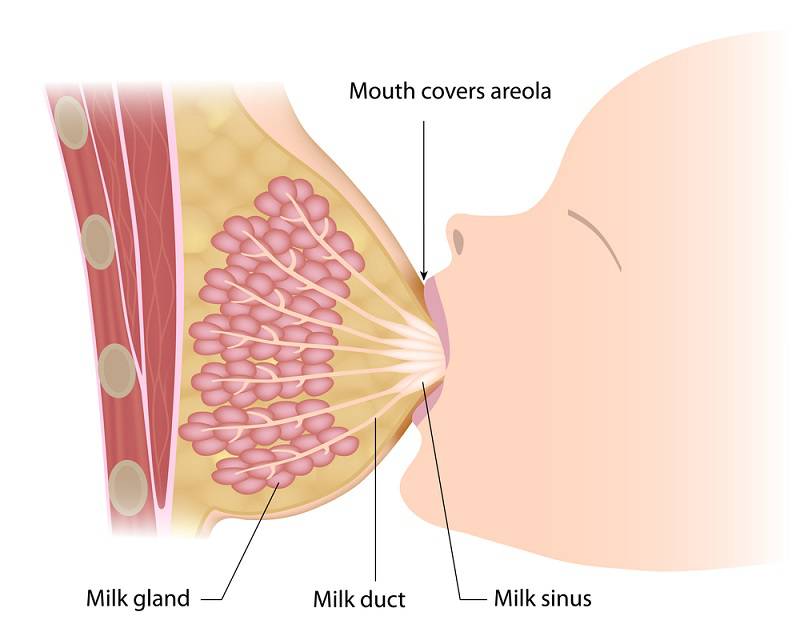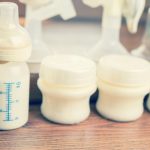Breast Engorgement: All you need to know

What is Breast Engorgement?
Breast engorgement is the state of the breasts (also known as mammary glands) being filled with milk. Engorgement is a normal part of lactation which almost every breastfeeding mother goes during her days of breastfeeding.The accumulation of milk leads to the buildup of pressure and the subsequent expansion of the breasts. This condition usually occurs during the first few days after the birth of the baby.
What is the structure of the breast and how is breast milk produced?
The breasts consist of connective and fat tissues. These surround and protect the cells which are responsible for the production of milk. Breast milk is produced within a small group of cells called alveoli. The alveoli are connected to the nipples through the structures known as ducts.
The process of milk production begins with the suckling of the nipples by the infant. The infant’s actions lead to what is known as “the let- down reflex which involves the stimulation of the nerves which are present around the nipples, which in turn triggers the pituitary gland to release two hormones namely prolactin and oxytocin. Both of these hormones have a vital role to play in the production of milk.Prolactin instructs the alveoli to convert the nutrients present in the blood into milk.On the other hand, oxytocin causes the alveoli to contract and eject the milk through the nipples.
What are the causes of breast engorgement?
Breast engorgement depends on the supply of milk by the mother and the demand for the milk by the infant. Any situation which leads an imbalance between the supply and demand for milk often results in the engorgement of the breasts. Typically there are four factors which are known to cause breast engorgement including the following:
Increased Milk Production:
The sudden increase in the production of milk by the breast is a common occurrence. The large volume of milk within the breasts might exceed the capacity of the alveolar to store it properly.
Stopping Breastfeed:
If the mother, due to any reason, stops breastfeeding for prolonged periods of time, it gives the alveoli the opportunity to produce additional amounts of milk and thereby cause further expansion of the breasts.
Baby’s Change in Appetite:
If the baby, stops breastfeeding on its own due to a change in appetite or a change in the choice of food the baby consumes, for example the baby might prefer to eat solid food as compared to milk. If such a thing happens then it would only lead to the accumulation of more and more milk within the breasts.
Breasts not being pumped enough:
Pumping or nursing the breasts requires the mother to press the nipples and causes outflow of breast milk manually. If after realizing that the baby is not showing an interest in being breastfed and therefore the mother is unable to breastfeed multiple times a day, the mother decides or forgets to pump her breasts. This inturn may result in her breasts being engorged.
What are the signs and symptoms of a woman who has breast engorgement?
There are a number of signs and symptoms which a new mother experiencing breast engorgement might complain about including the swelling of the breasts, the heaviness and pain a woman might feel. In some cases, the breasts are engorged to such an extent that they cause the nipples to become retracted and the affected woman might even believe that her breasts would explode at any time without warning, such women often develop a fear of breastfeeding and tend to avoid feeding the baby which could prove detrimental for the health of the baby.
How is breast engorgement diagnosed?
Since breast engorgement occurs in almost all new mothers, it is important that women get themselves checked by a doctor and diagnosed promptly in order to understand whatever changes their bodies might be going through.
A look at the medical history, signs and symptoms as well as physical examination is usually enough for a doctor to make a diagnosis of breast engorgement.
What is the treatment for breast engorgement?
Breast engorgement might be a very painful condition but the good thing is that this condition does not last very long. Breast engorgement gradually subsides after the first couple of weeks and often by the end of a period of six weeks, the mother admits to feeling a lot better and healthy. Doctors have recommended a very ways in order to manage breast engorgement properly including:
Increase Feeding:
The mother should breastfeed the baby multiple times a day. The frequency oftenvaries from about ten to twelve feeds in 24 hrs.
Breast Support:
Wearing a supportive bra is considered beneficial for the new mother with breast engorgement as it seems to provide a sort of cushion for her very painful breasts.
Application of heat or warm shower:
Using a heating pad on the breasts makes breastfeeding, pumping or nursing the breasts quite easy and simple as the heat helps with the let-down reflex.
Use Cold Compress between Feedings:
Application of cold ice cubes on the breasts provides the mother with temporary relief from the intense pain which she might be experiencing.
Use a breast pump to remove breastmilk:
If, for any reason such as illness, change in appetite etc., your baby is not being regularly breastfed, use a breast pump to remove breastmilk from your breast. The removed breastmilk can be stored in breastmilk storage containers and can be used to feed your baby later. Learn more about breast pumping and breastmilk storage here.
Trying Cabbage Leaves:
Placing cold cabbage leaves against the breastfeeding mother’s breasts is a method of treatment of breast engorgement that is being used for hundreds of years. The method is to simply place the cold cabbage leaves against the breasts for around 20 minutes or so. However, this method is not recommended if you have other medical issues along with severe breast engorgement. Further, if your have any sort of breast or nipple injury or irritation, this method is not advisable to treat breast engorgement.
Wear a bra that is not too tight:
If a breastfeeding mother is going through breast engorgement, a lose fit bra is highly recommended. If your bra is too tight, it may cause the milk to be trapped in the lower milk ducts and further increase the engorgement problem.
Most Viewed
-
5 Common Methods of Contraception
Last updated On by Percy Oad -
How to Cope with Male Infertility
Last updated On by Alina -
What is the Difference Between Primary and Secondary Infertility?
Last updated On by Madison -
How to start a child-free life after infertility
Last updated On by Jacinta






